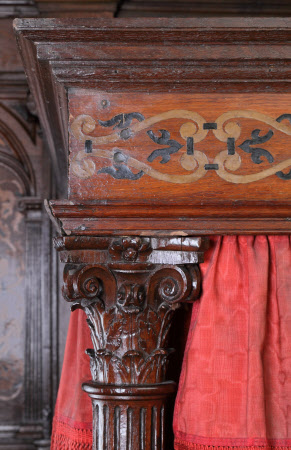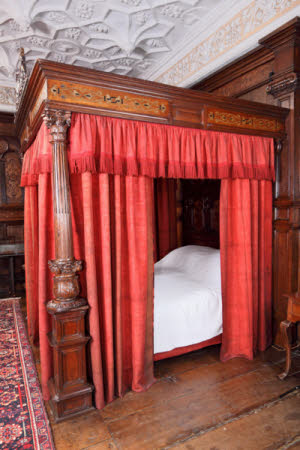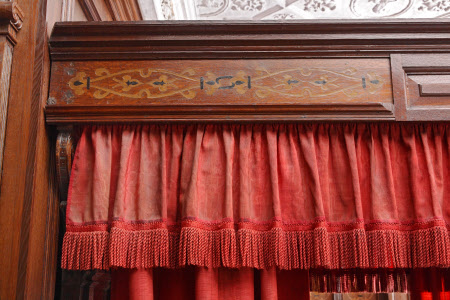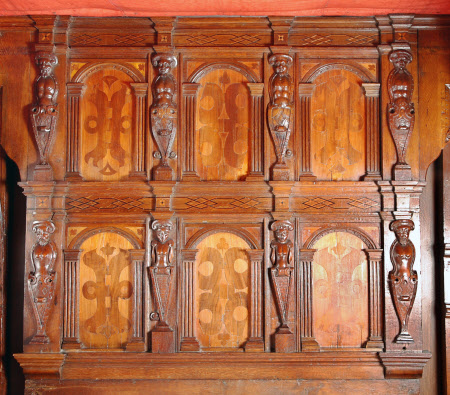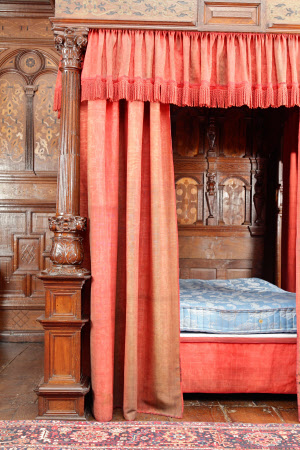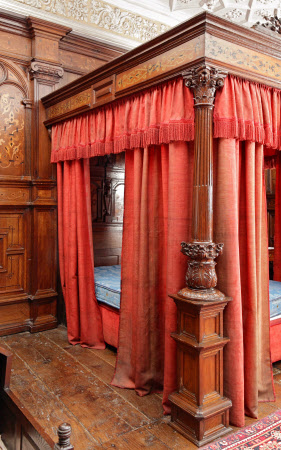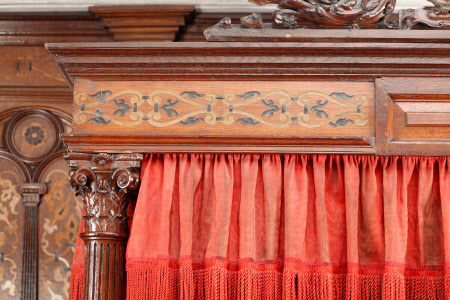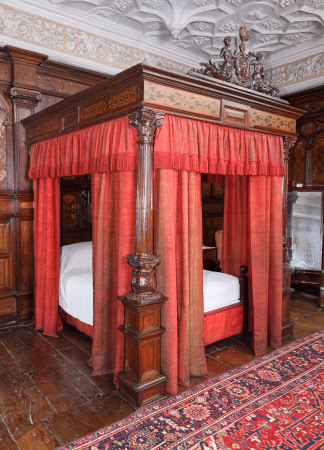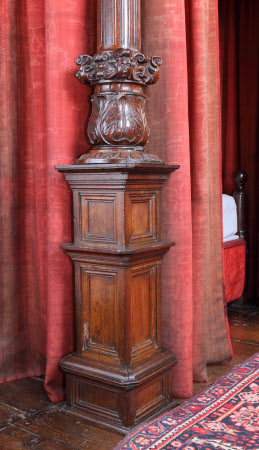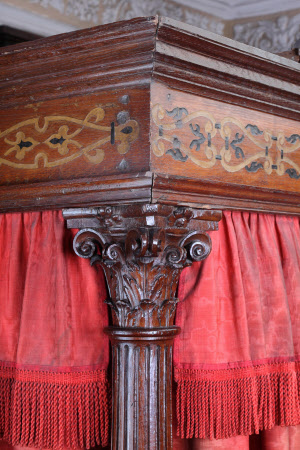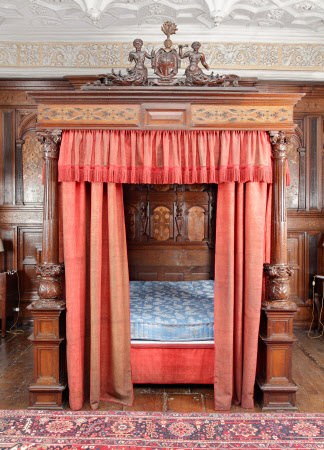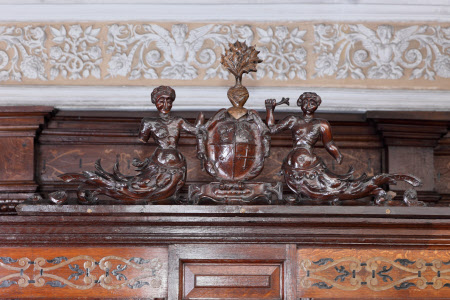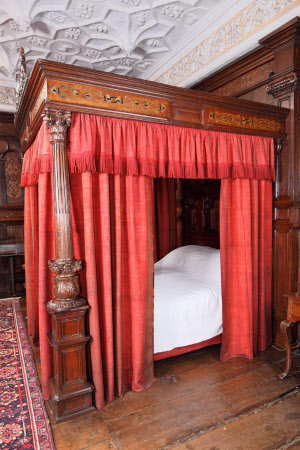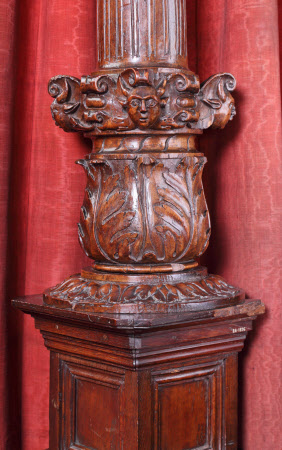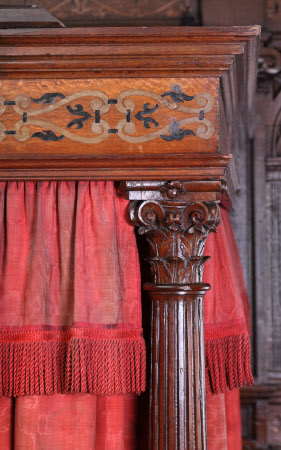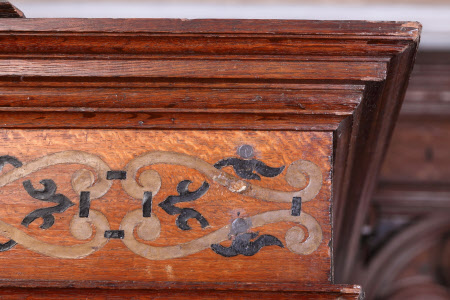Tester bed
Category
Furniture
Date
circa 1580 (and later)
Materials
Carved, turned and joined walnut and oak, poplar, some inlay of putty, hangings of moreen
Measurements
240 x 213 x 245 cm
Place of origin
Westmorland (England)
Order this imageCollection
Sizergh Castle, Cumbria
NT 997761.1
Summary
A walnut, oak and poplar tester bed, with later repairs in oak and inlay to the cornice in putty, England, probably Westmorland, circa 1580. The hangings of red moreen. Topped by a pediment [NT 997761.2] dated 1568, but this has been re-used from elsewhere in the house. The bed with moulded cornice inlaid with arabesques and geometric strapwork, and each long frieze centred by a rectangular panel. The tester later (the one on the bed at Sizergh [NT 998027] possibly once belonged here), the headboard of two registers of three arcaded panels, all with walnut inlaid on poplar in broad designs. The registers separated by friezes inlaid with geometric strapwork and spaced by projecting pilasters applied with figural terms on waisted and scroll-carved tapering pedestals. A run of plain panels below. The freestanding footposts turned from walnut and of broadening stop-fluted form topped by Corinthian capitals above a collar carved with grotesque masks and an acanthus-wrapped bulb. Raised on paneled oak plinths with later oak repairs.
Full description
A walnut, oak and poplar tester bed, with later repairs in oak and inlay to the cornice in putty, England, probably Westmorland, circa 1580. The hangings of red moreen. Topped by a pediment [NT 997761.2.2] dated 1568, but this has been re-used from elsewhere in the house. The bed with moulded cornice inlaid with arabesques and geometric strapwork, and each long frieze centred by a rectangular panel. The tester later (the one on the bed at Sizergh [NT 998027] possibly once belonged here), the headboard of two registers of three arcaded panels, all with walnut inlaid on poplar in broad designs. The registers separated by friezes inlaid with geometric strapwork and spaced by projecting pilasters applied with figural terms on waisted and scroll-carved tapering pedestals. A run of plain panels below. The freestanding footposts turned from walnut and of broadening stop-fluted form topped by Corinthian capitals above a collar carved with grotesque masks and an acanthus-wrapped bulb. Raised on paneled oak plinths with later oak repairs. Thought to have been made at the same time as the paneling to the Inlaid Chamber, where this bed stands, which places it in the late 1570s and/or early 1580s. Later repairs mean that we are not absolutely clear how this bed would have appeared when it was made. The footposts, however, clearly derive from the designs of Jacques Androuet du Cerceau I (c. 1510 - c. 1585): a canopy in an etching of his printed circa 1565 - 1570 is supported on fluted columns which are encircled by a collar of winged masks which echo the grotesque masks to the posts of this bed. Another bed at Sizergh, which probably dates from the 1560s [NT 998261] has a collar of winged masks to its posts. A bed sold at Christie's as part of the John Fardon collection in 1996, dated 1570, has identical carved bulbs. The bed was repaired and altered in the late 18th and early 19th centuries, which is probably when the pediment was added. A 1785 inventory of the room lists 'a Venerable Old Oak Carved bed with Teaster & headboard and Posts all repair'd 1779 by Abreham Story Cabinetmaker'. He probably renewed the paneled oak plinths with oak, and re-worked the canopy and tester and possibly inlaid the frieze to match the room's paneling, except that the 'inlay' used here is linseed oil putty. After these repairs, and probably in the early 19th century, the bed was decked out with red moreen hangings which survive today. The bed, and its pediment, were sold to the Victoria & Albert Museum in 1896 for £400, and joined the paneling on display in the West Wing of the Museum, which had been sold five years earlier for £1000. (Megan Wheeler, October 2016)
Provenance
Probably commissioned by Thomas Boynton (d. 1582) and/or Alice Boynton (d. 1585). Sold with the stained glass roundels to the window to the Inlaid Chamber, to the South Kensington Museum in 1896 for £400. Returned to Sizergh on a long loan in 1978. Transferred back to the ownership of the National Trust in 2016.
References
Wells-Cole 1997 Anthony Wells-Cole, Art and Decoration in Elizabethan and Jacobean England: the influence of continental prints, 1558-1625, New Haven & London 1997, p. 21 Goodall, 2002: Ian Goodall. “Privacy, display and over extension: Walter Strickland’s rebuilding of Sizergh.” Antiquaries Journal 82 (2002): pp.197-245. (Clifford-Smith, 1915), H. Clifford-Smith, 'The Panelled Rooms IV: The Inlaid Room from Sizergh Castle' (V & A Museum Department of Woodwork, 1915), pp. 28 - 29
